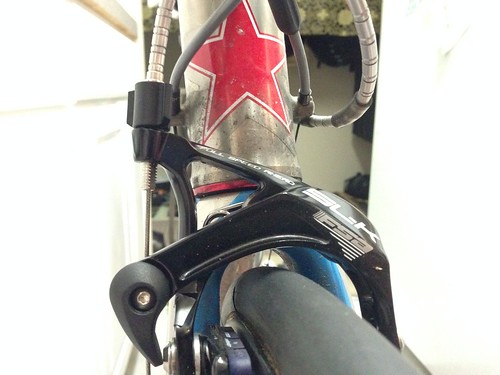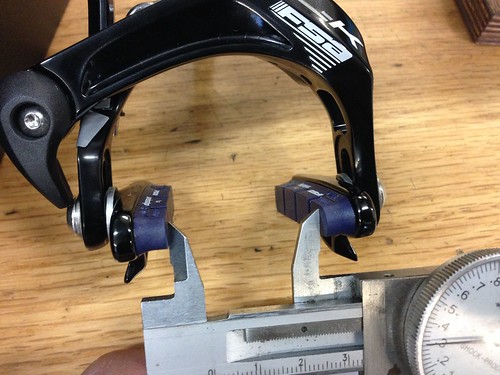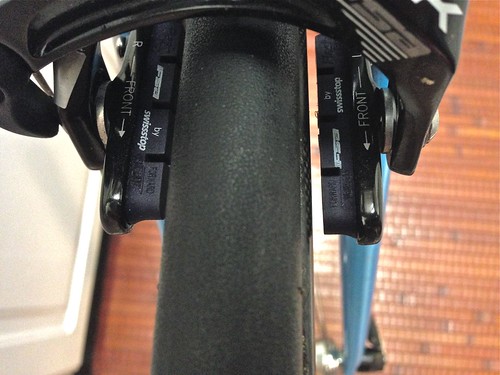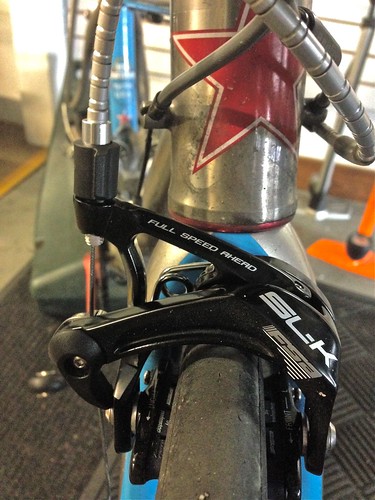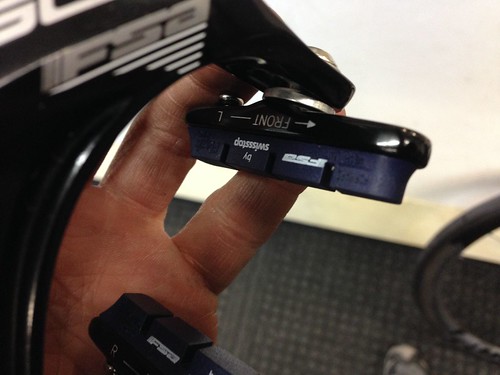Today’s aero wheels offer bolt-on speed with relatively tame handling traits, making them suitable for a wide variety of race conditions. While they’re not cheap, aero wheels are the single best performance upgrade for your bike and are a more cost-effective choice than an “aero road bike” frame. But for many racers, acquiring high-end race wheels will leave precious little equipment budget. So imagine if you dropped big money on the wheels only to find out that your brake calipers don’t open wide enough to fit them. Sure, the latest versions of SRAM Red and Dura Ace will fit thicky aero rims, but your credit card is still smoking form the wheel purchase. Full Speed Ahead has your back with the upgraded SL-K brakeset.
Certainly more beneficial than internally routed shifter cables, lightweight QR skewers, or an 11sp cluster, recent aero wheel designs have carbon rims with a section that is thickest towards the middle of the depth and a smooth transition from the tyre to the rim. Wheel designs pioneered by Hed and Zipp. These rims penetrate the air well straight on, but also perform well when the wind vectors in from some angle off zero degrees ahead. Such wheels are also known for having more docile behaviour in side gusts. These characteristics come from the shape of the rim/tyre having a smooth shape to the leeward surface, so that the air keeps a smooth, laminar flow over most of the surface before it breaks loose in turbulent swirls. Ironically, thick sections were the total opposite of aerodynamically-minded bicycle design from the 1980s to less than ten years ago. Back then, narrow was the goal, and “aero” rims were 19-20mm wide right next to the tyre (ie the brake track) and drew back to sharply tapered trailing edges. Today’s best designs are often close to 28mm wide at their thickest point in the middle of the rim depth; they are often 25mm or more at the brake track. This has created an odd situation for brake manufacturers. From entry-level to high-end, road calipers for the last couple decades were optimized for rims like the Mavic Open Pro (20mm wide). They just can’t open big enough for these new aero wheels. High-end brake designs introduced in the last couple years such as the SRAM Red Aero-Link caliper have been revised, but the ability to open wide hasn’t trickled down to the Force or 105 level yet.
Meanwhile, FSA has aggressively adapted to market needs and eagerly steps up to provide for consumers and OEM. The updated SL-K calipers spread to 33mm with unworn pads, enough to accommodate a 28mm rim. This spread is especially for the rear wheel position, where the narrow spoke bracing and torque from the rider cause the rim to flex side to side. The SL-K calipers weigh a respectable 314gr with mounting hardware (verified). The cable-pull ratio should be compatible with both newer Shimano levers as well as SRAM/Campagnolo, though depending on your preferences the SL-K might feel a little low on leverage with the Shimano. I rode the calipers with SRAM Red levers, and I found the braking performance to be better than 1st-gen Red calipers and close to the new Aero-Link. However, the new Aero-Link calipers are a cam-actuated single-pivot brake as opposed to the SL-K and original Red. This makes the SL-K much easier to center the pads, since you can just pull the caliper with one hand and retighten the fixing nut; whereas the Aero-Link is almost impossible to center without two wrenches. And at less than $200, the SL-K brakeset is much less expensive.
The SL-K’s all black finish should compliment most bikes, it comes stock with SwissStop BXP (all-weather blue compound for alloy rims), and has a ratcheting QR. My only gripe is that the barrel-adjuster feels a little weird and is awkward to spin though it turns smoothly.
One thing to keep in mind when setting up these brakes is whether you’ll be using aero wheels AND conventional alloy rims on the bike; this is an issue with other designs too. I would suggest that you initially set up the calipers with QR full open on the widest rim you plan to use, so that way you can use the throw of the QR to partially adjust for when you slip in the narrower rims. Oh, and don’t forget to run carbon-specific pads for your carbon-aero wheels.
…We're riding townies, adventure, and mountain bikes. Find recommendations on our store page. As Amazon Associates we earn from qualifying purchases.
